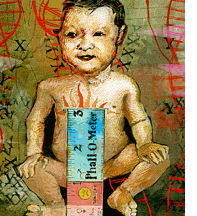Sex Police
 The biology of sex is being hotly debated, as parents, doctors and researchers reevaluate what it means to be male and female.
The biology of sex is being hotly debated, as parents, doctors and researchers reevaluate what it means to be male and female.
By Sally Lehrman, 1999
Patrick took a long time in coming -- two weeks in the birth canal -- but the moment he arrived, nurses bundled him up and rushed him out of the delivery room. The Jacksonville, Fla., hospital cloistered the eight-pound, 20 1/2-inch baby in a back section of the intensive care unit and drew the curtains. One doctor after another went to visit. The infant had a well-defined penis, but with an opening at the base, not the tip. There was just one testicle, though it was producing plenty of testosterone. In most of his cells, the baby had no Y chromosome, the one that contains the genetic instructions for the body to develop as a male. The doctors assured the adoptive mother, Helena Harmon-Smith, that Patrick was a girl. They would remove the offending appendages right away.
But Harmon-Smith had seen Patrick have an erection. Actually, several. "You're not cutting off anything that's working," she protested. The authorities checked the infant's internal organs and still insisted this baby would be better off as a girl. His mother refused. More tests. After 11 days, 20 doctors filed into a hospital conference room and solemnly announced that they would allow the family to raise Patrick as a boy. "We put him in a little tux and took him home," Harmon-Smith says.
Two and a half months later, Patrick's doctor warned his mother that the boy's testicle, really an ovotestis that also contained some ovarian tissue, was probably malignant. It should be removed -- like the one already taken from his abdomen. His mother finally agreed to a biopsy, just in case. When the surgeon returned from the operating room, he said the gonad was diseased. He had cut it off.
Harmon-Smith pestered the doctor for the pathology report for more than a month. Once she got it, "the first thing I read was 'normal, healthy testicle.' My heart stopped. I just cried," she says. Five years old March 24 and in the first grade, Patrick will never be able to produce semen.
"My son is now a non-functioning eunuch. Before, he was a functioning male," Harmon-Smith says. "I don't think the doctor cared. His reasoning was that this was a hermaphrodite, so everything should be removed."
Quietly and in near secrecy, pediatric urologists and other specialists decide what are the minimum qualifications for manhood, correcting any babies with ambiguous genitalia -- known as "intersexed" -- before their births are announced to the world. Under the urgent conditions of a medical emergency, they decide whether a smallish appendage is a proto-penis or a maxi-clitoris, and perform the surgery to make it so -- sometimes without even telling the parents the truth about their child, and rarely revealing anything to the patient as he or she grows up. Guiding the doctors' work is a commonly accepted theory, pioneered in 1955 by Johns Hopkins University sexologist John Money, that infants are psychosexually neutral at birth. If a surgeon sculpts a baby's undersized, oversized or otherwise confusing genitals to match a sex label within a few months of birth, normal psychosexual development will follow.
But evidence is building that sexual identity is not so easy to manage or mold. New studies in human development are demonstrating that the biological division between male and female isn't clear-cut or even stable. The simple presence of a Y chromosome -- considered by many people to be as male-identifying as a six-pack of Bud and a 4-by-4 Dodge Ram -- isn't necessarily enough to make a man. And frilly dresses adorning a body shaped to be female can't always contain the guy hidden inside.
The questions aren't limited to hospital birthing rooms. From sports arenas to geneticists' labs, experts are struggling to find new ways to define and describe the biology of sex. And some members of the medical establishment are beginning to question whether intersex surgeries make sense in infancy, before the child has a chance to reach puberty, develop his or her own sense of identity and give consent. Later this month, academic surgeons and pediatric urologists meet in Dallas to thrash out the psychological, hormonal, surgical and practical issues of intersex treatment. Their debates are likely to get hot.
Since the 1960s, most doctors confronted with a baby like Patrick would likely excise his penis and testicle shortly after birth and call him a girl. If he had a Y chromosome, they might keep the penis but rebuild the urethra to reach the organ's tip. If he had two XX chromosomes like most girls, but an extra-large clitoris that could be mistaken for a penis, they'd trim it back. Or if he had the right chromosomes but a very small penis, off it would go. The surgeons were certain that life without the appropriate genitals would be impossible, and as recently as last year, an article in Pediatric Nursing suggested that doctors ought to consider it child abuse if the parents refused genital remodeling.
Katherine Rossiter, the pediatric nurse practitioner who wrote the article in the January-February 1998 nursing journal, argues that intersex activists represent only a minority, albeit a vocal one, and that allowing a baby with a tiny penis and no testicles to grow up as a boy, rather than surgically reassigning him as a girl, might harm him beyond repair. But she admits that "listening to what real people say and their arguments" has broken down some of her conviction. "I've become muddy mishmash in my thinking," she says.
The medical literature and the opinions of specialists are increasingly divided. "In some cases it's led to a human tragedy -- it might have been better not to reassign the sex of this particular child. But there are cases where it's clearly right to reassign," says Raymond Hintz, an endocrinologist and professor of pediatrics at Stanford University. "It's sometimes justified, but it's not something you do lightly."
William Cromie, a Chicago pediatric urologist who serves as secretary and treasurer of the Society for Pediatric Urology, stresses that proper treatment relies on the carefully considered opinions of parents along with ethicists, endocrinologists, pediatricians and other specialists. As many as 30 conditions may lead to a child being considered intersexed. "It's not an arbitrary, capricious decision by one person," he says. "You try to make the very best decision -- it's usually ground over by a lot of people who are very thoughtful. This is an area that's immensely complex. And lay people just plain and simple don't understand it."
However well-meaning, though, doctors who perform intersex surgery employ a very finite tool in making their decision. The first measure of manhood is a ruler: If a penis is less than one inch (2.5 centimeters) at birth, it doesn't count. And if it's more than three-eighths of an inch (0.9 centimeters) long, it can't qualify as a clitoris either. Any appendage that falls in the middle must be fixed. Then there's the question of the urethral opening, which must be in the right place -- men don't pee sitting down. A curving penis must also be corrected.
For a boy to be a boy, he ought to have two testicles just below a straight penis, and only one opening down there. If the genitals fall short, a pediatric urologist will almost always assign the infant a female gender, remove anything protruding too far and prescribe estrogen at puberty. A talented surgeon can construct a vagina using a piece of the bowel, although the woman who owns it will never experience any sensation inside.
Hale Hawbecker narrowly escaped such a prognosis. When he was born in 1960, his doctors, aghast at his small, perfectly formed penis and internal testicles, wanted to reassign him female. His parents refused, not comprehending the doctors' distress. "It's kind of a strict club in this country to be a man, with very rigid rules to qualify," says Hawbecker, now a Washington attorney who is developing a legal challenge to infant intersex surgeries in his spare time. "It doesn't matter if you're XY. If your penis is too small, you lose it."
Hawbecker says his penis size and absent testicles, removed in childhood, don't hurt his ability to love and make love to his wife. "I very happily engage in sex whenever I can. You have to be creative, and not so focused on genitals," he says. As for his own pleasure, "My penis does everything you'd expect a penis to do -- it's just small."
Hawbecker says he thinks like a man; with his clothes on, he looks typically male too. And yet, he says, "I guess I've never really felt like I fell neatly into the camp of guys. I love to cook. I love to take care of things around the house. I hate the Three Stooges and I don't like football." Often, he thinks about the female he might have become; where she'd be right now. "I think she'd be OK. I could've done 'girl' too. I could be happy that way, too. That's what's mind-boggling."
Medical literature says that about one in 2,000 babies is born like Hawbecker or Harmon-Smith, with uncommon variations of genitals and gonads, or sex-conditioning hormones that don't match sexual organs. About one in 1,000 women has three X chromosomes instead of the usual two; some people have had as many as four X chromosomes -- plus two Ys. Some women have facial hair, some men don't. Breast size, voice timbre and body structure, all generally accepted cues, also can contradict chromosomal identity.
"The basic story is, it isn't simple," says Alison Jolly, a Princeton evolutionary biologist who studies ringtail lemurs in Madagascar. "It's all just more complicated than people will admit." In the first few weeks of life, every human embryo develops the equipment for both sexes, the foundations for both ovaries and testes. At about eight weeks, a chemical chain of events stimulates one set to disintegrate. One week later, the external genitalia begin to form -- and usually, to match what's left inside.
All this seems to be triggered by a spot on the Y chromosome called SRY, for "sex-determining region, Y chromosome," that scientists have dubbed the "master switch." Throw it, they say, and a chain of events run mostly by genes on the X chromosome leads to the development of testes and the production of male hormones. Without SRY, females continue along what molecular biologists have dubbed the "default" pathway. In February, however, researchers reported the first evidence that an active signal stimulates female development, too.
Of course, there's a lot more going on as well -- much of it still not even vaguely understood. A wash of hormones primes the brain for one sex or another, though not always the same as the one indicated by genitalia at birth. Jolly suggests looking at sex as statistical -- a compendium of characteristics that, when plotted on a graph, looks like a couple of camel humps. One set of features tends to be viewed as male and the other female. The section in between is as normal as the outlying regions in the land of "super-macho" and "super-fem."
From classical antiquity through the Renaissance, anatomists thought there was just one sex, and it was male. Female bodies simply mirrored the male reproductive organs -- with the vagina an inverted penis; the ovaries, interior testicles. During the 18th century, the idea of two separate sexes took hold. Then in 1993, Anne Fausto-Sterling, a well-regarded biologist and feminist studies theorist at Brown University, raised a ruckus when she proposed that male and female were not enough. In a tongue-in-cheek proposal, she recommended five categories in all.
Some people seized upon the idea as a revelation finally explaining their own bodies. Others felt the thesis went too far. Fausto-Sterling says her readers were taking her too literally. She has abandoned the proposal -- which at root simply challenged people to think differently about sex -- and now wants to eliminate the term from our vocabulary. "There is no sex; there's gender," Fausto-Sterling says.
Fausto-Sterling argues that scientific discoveries about the ways our bodies work employ cultural understandings and, as in the male "master switch" and female "default pathway," the language of existing social models. Whenever faced with a lack of clarity, surgeons get out the ruler and make a choice. "There's a set of decisions by which we're going to socially agree what is a penis. How we organize the continuous variability that nature offers us is what gender is about," Fausto-Sterling says. "What we call the truth of the body is also a cultural view of the body through a scientific lens."
Both the scientific and social interpretations are increasingly complicated and controversial. The International Olympic Committee has found itself at the center of the uncertainty. The first shock came when Hermann Ratjen, who ran as Dora Ratjen for Germany in the 1930s, confessed in 1957 that he had disguised himself at the request of the Nazi Youth Movement. So in 1966, as the opportunities for women to compete expanded rapidly, a panel of judges began checking female athletes for vaginal openings, overlarge clitorises, a penis or testicles. By 1968, chromosome testing replaced these "nude parades," and in 1992, a more sophisticated instrument to hunt for the SRY gene was adopted. But as the technology advanced, so did the confusion.
Five women out of 2,406 tested "male" in the 1992 Barcelona Olympics. Eight women in the 1996 Atlanta games didn't pass as females. In February, the Athletes' Commission of the International Olympics Committee urged its parent organization to do away with sex analysis entirely and rely instead on observed urination during drug testing to pinpoint any likely imposters.
Anatomy, gonads, hormones, genes, rearing, identity and even the presumptions of others all play into a person's sex. "To select only one, the genetic sex, out of a large number of sex-determining factors and analyze for that one is scientifically incorrect," says Arne Ljungqvist, head of the International Amateur Athletics Federation doping commission.
Both women and men in sports have begun to accept a broader definition of what a "woman" is, accepting those with chromosomal variations and sometimes even testes. Intersex activists hope pediatric specialists also will quit worrying about what those jock straps contain -- and indeed, some already have.
William Reiner, who started out as a urologic surgeon, went back to school after witnessing the misery of children living with the results of sex-correction surgery. Now a child psychiatrist at Johns Hopkins University, he says the most important sex organ is the brain. Reiner doesn't buy any theories about a range in biological sex; in fact he thinks it's quite binary. All the more reason to step back from aggressive enforcement, he says. Sure, go ahead and assign sex at birth, he suggests, but in the final analysis boys will be boys, girls will be girls, and they know what they are better than any parent or doctor.
Some surgeries are medically necessary, and many seem to turn out just fine. Reiner hopes to sort out some of the mysteries by following the lives of 700 children born with atypical genitals, 40 of whom had their sex reassigned at birth. "The kids are going to tell us the answers," he says. Cheryl Chase thinks she knows some already. She founded the network that grew into the Intersex Society of North America, a clan of 1,400 whose anatomy doesn't fit the binary ideal. Born with both ovarian and testicular tissue, Cheryl started out life as Charlie. But doctors decided later that since she was potentially fertile and had a short penis, she'd be better off as a girl. Her parents changed her name, threw away photographs and birthday cards and had her clitoris removed when she was 18 months old. Her ovotestis came out at age 8. She was in her 20s and living as a lesbian in the 1970s when she dug up the truth about her birth and life as a boy -- making her feel like an imposter in her own community. And for her, like many others who had surgery on their genitals, the missing parts and scarring made sex more likely to bring pain than pleasure.
The Intersex Society doesn't oppose assigning gender at birth. Instead it -- and now some medical specialists -- urges parents and doctors to refrain from surgery and be open to a change in sex identity later.
But Chase, for one, isn't waiting for culture to come to terms with biology. "I'm focused on practical changes that come quickly, not pie in the sky," Chase says. "I would much rather keep my clitoris and have orgasms than have a box to check off."
Helena Harmon-Smith, Patrick's mother, says she wants children like her son to be allowed their own decisions -- and more than anything, to be recognized as real. "My son was one of the lucky few -- because he is technically both. He can be boy or girl," she says. She will never forgive Patrick's doctor for making the choice for him.
next: The True Story of John / Joan
~ all inside intersexuality articles
APA Reference
Staff, H.
(2007, August 9). Sex Police, HealthyPlace. Retrieved
on 2025, December 19 from https://www.healthyplace.com/gender/inside-intersexuality/sex-police

